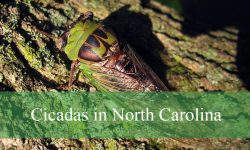Across Montana’s vast landscapes, grasshoppers thrive in prairies, rangelands, and alpine meadows, with over 400 species recorded. Some play key roles in the ecosystem, while a few can impact crops when populations rise.
Sizes, colors, and behaviors vary widely among these insects. From the bright green Short-winged Green Grasshopper to the large, flightless Plains Lubber Grasshopper, each species presents unique identification challenges and fascinating traits.
This guide presents 20 of Montana’s most common grasshoppers, offering detailed identification tips, habitat insights, and feeding habits. Naturalists, gardeners, and students alike will find this resource helpful for understanding these remarkable insects.
Common Grasshoppers Found in Montana
Alkali Grasshopper (Trimerotropis salina)
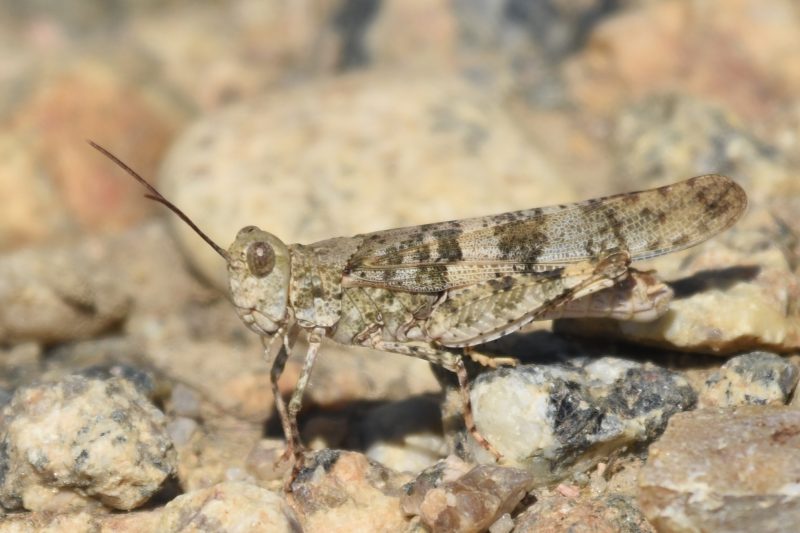
The Alkali Grasshopper is a medium-sized species commonly found in alkaline or saline soils in Montana. Its body is generally grayish-brown with faint patterns that provide excellent camouflage against the sandy or salty ground. Adults typically measure 25–35 mm in length, with hind legs adapted for powerful jumps.
Identification is aided by its distinctive light stripe running along the side of its thorax and the slightly mottled wings. Males often have shorter wings than females, which can be a useful way to differentiate sexes in the field. Their antennae are relatively short compared to other species in the region.
This grasshopper prefers dry, open habitats such as saline flats, desert-like plains, and disturbed areas with sparse vegetation. They are commonly observed in late spring and summer when temperatures rise. Seasonal populations can fluctuate depending on rainfall and soil conditions.
Feeding primarily consists of grasses and low-growing herbaceous plants. Alkali Grasshoppers are relatively sedentary, often staying close to their preferred soil types. While not a major economic pest, they can contribute to local grazing pressure in rangelands.
Alpine Grasshopper (Melanoplus alpinus)

Alpine Grasshoppers are small to medium-sized and typically found in higher elevation meadows and montane zones. Their bodies are a pale brown to tan color, often with subtle greenish tones on the thorax. Adults reach about 20–30 mm in length, and their hind legs are proportionally long to facilitate jumping across uneven alpine terrain.
Identification is marked by short wings and a slightly arched pronotum with faint longitudinal stripes. Females often appear bulkier due to their reproductive organs, and both sexes display subtle mottling that helps them blend into grasses and rocks.
They inhabit alpine meadows, tundra-like areas, and mountain slopes above the tree line. These grasshoppers are active during warm days and often seek shelter under stones or clumps of grass when temperatures drop. Their distribution is limited to cooler, high-altitude regions.
Alpine Grasshoppers feed mainly on grasses and low alpine vegetation. They are slow movers compared to lowland species but can be abundant locally, forming small aggregations where vegetation is dense. Their life cycle is often synchronized with the short growing season of mountain ecosystems.
Ashy Spur-throat Grasshopper (Melanoplus cinereus)
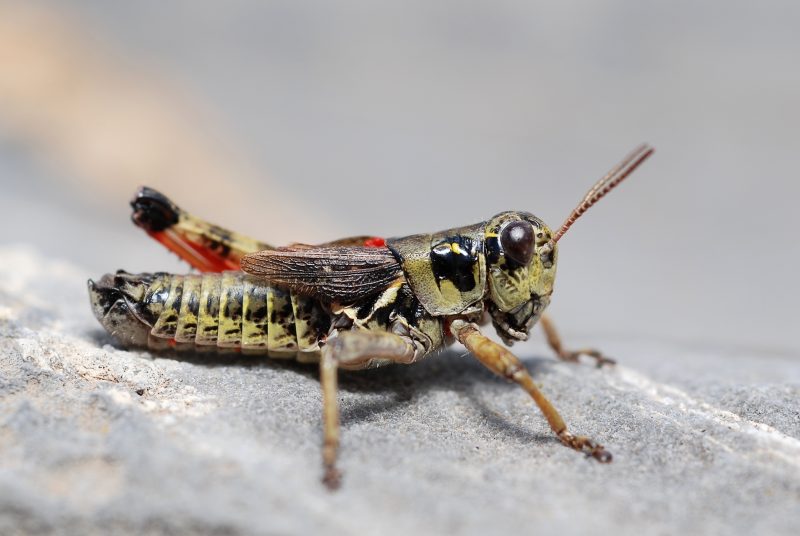
The Ashy Spur-throat Grasshopper is medium-sized and recognizable by its ash-gray coloration, which provides excellent camouflage in dry grasslands. Adult body length ranges from 22–32 mm, with females generally larger than males. Its hind legs are strong and adapted for long jumps.
It can be identified by the subtle spur or projection on its throat, a characteristic feature of the genus Melanoplus. The pronotum is slightly convex with faint longitudinal lines, and the wings are usually short in females, sometimes barely reaching the abdomen tip.
Ashy Spur-throats are commonly found in prairies, rangelands, and open meadows in Montana. They prefer dry, well-drained soils and are often abundant in areas with native grasses. Seasonal emergence peaks in mid to late summer when conditions are warm and dry.
Their diet consists mainly of grasses and forbs, but they occasionally feed on crops when natural vegetation is sparse. They tend to remain in small groups and are relatively inconspicuous due to their cryptic coloration. Despite their numbers, they rarely reach outbreak levels that threaten agriculture.
Big-headed Grasshopper (Aulocara elliotti)
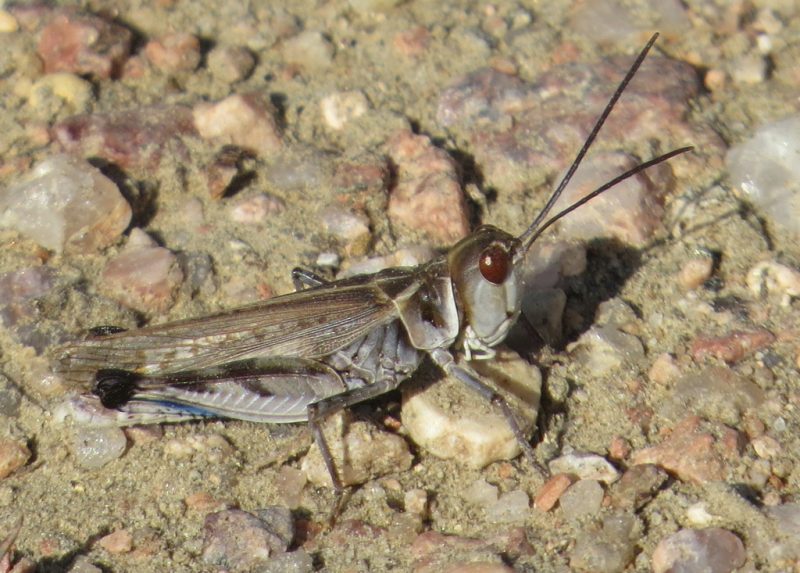
Big-headed Grasshoppers are medium-sized grasshoppers named for their proportionally large heads relative to their bodies. Adults measure 25–35 mm in length and have strong hind legs for jumping. Their coloration is typically a combination of brown and yellow, which helps them blend into the dry prairie soils.
Identification is aided by the prominent head and the sharply angled pronotum. Wings are usually short, especially in females, and the hind femur often has dark bands or spots. Males are slightly smaller and more slender than females.
They inhabit open prairies, dry grasslands, and pastures in Montana. They are most commonly observed from late spring through early fall. Big-headed Grasshoppers are well adapted to hot, dry environments and can be abundant in rangeland areas.
Their feeding behavior focuses primarily on grasses, which can sometimes make them a minor pest in pastures. They are diurnal and tend to stay close to the ground, often hopping from plant to plant rather than flying long distances. Population levels fluctuate with annual rainfall and plant availability.
Barren Land Grasshopper (Trimerotropis pistrinaria)
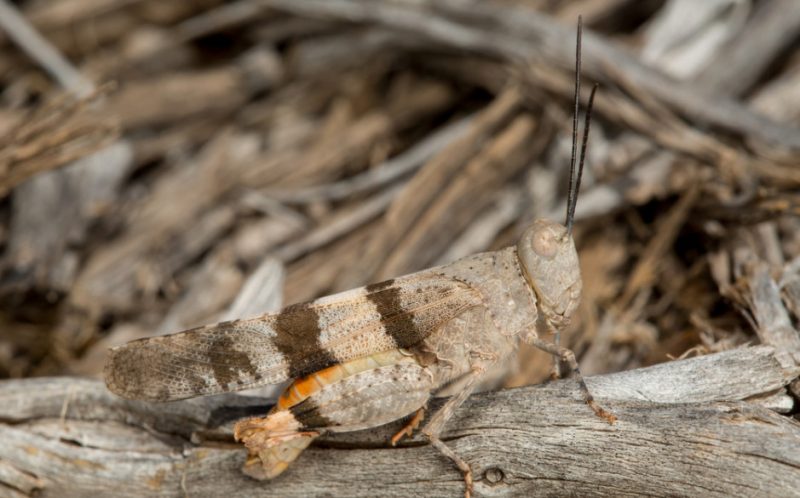
The Barren Land Grasshopper is medium-sized, with a body length of 25–30 mm, and is typically light brown with subtle darker patterns along its wings and thorax. This coloration allows it to blend effectively with sandy or gravelly soils of Montana’s barren landscapes.
Identification features include slightly translucent wings with faint spotting and a narrow pronotum. Its hind legs are long and muscular, enabling it to make powerful jumps. The antennae are short and segmented.
They inhabit sparsely vegetated areas, including dry plains, sandy soils, and gravelly open land. They are most active during warm months and can be spotted on roadsides or bare ground where vegetation is minimal.
Barren Land Grasshoppers feed primarily on low grasses and herbaceous plants. They are highly mobile within their habitat but generally do not cause significant crop damage. Their populations can expand in years with favorable weather conditions, leading to temporary local abundance.
Carolina Grasshopper (Dissosteira carolina)
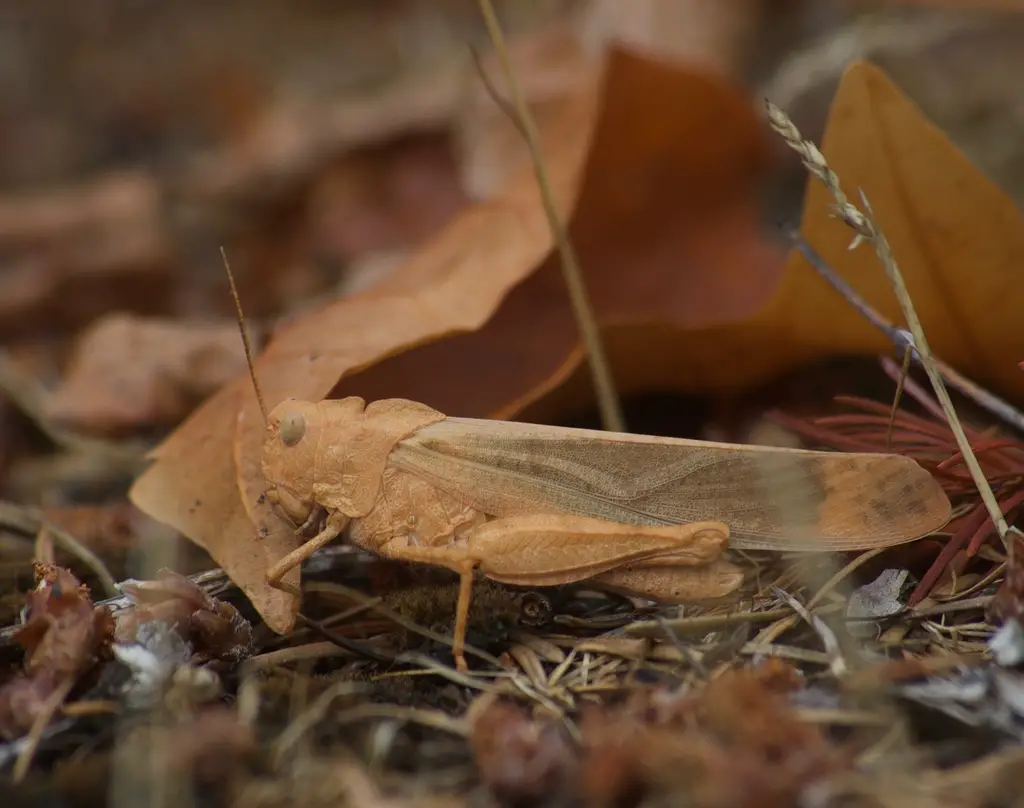
The Carolina Grasshopper is a large, slender grasshopper with adults ranging from 30–50 mm in length. Its body is usually light brown to gray, blending well with dry, open soils. The hind wings are broad and dark with a yellow-orange hue along the edges, which produces a flashing display during flight.
Identification is aided by the broad wings and the characteristic dark bands on the forewings. The pronotum is slightly rounded with fine ridges, and the antennae are relatively short. Males are smaller and slimmer than females, which often appear more robust.
Carolina Grasshoppers are common in disturbed sites such as roadsides, fields, and gravelly areas. They are often observed in urban and suburban environments, in addition to natural open habitats. Adults are most active during warm summer days and can fly short distances when disturbed.
They are generalist feeders, consuming grasses, forbs, and occasionally crops. Their striking wing coloration can startle predators, and they rely on both jumping and short bursts of flight for escape. While not typically considered a major pest, large populations can cause local damage to vegetation.
Clear-winged Grasshopper (Camnula pellucida)

Clear-winged Grasshoppers are medium-sized, measuring 25–35 mm in length, with translucent wings that give them their name. The body is light brown or tan, often with subtle speckling, providing camouflage against dry soil and grass.
Identification is based on the clear hind wings, short forewings, and slightly humped pronotum. Females tend to have shorter wings than males, and both sexes have strong hind legs adapted for jumping. The antennae are moderately long and slender.
They inhabit open prairies, fields, and rangelands, preferring dry, exposed soil with sparse vegetation. These grasshoppers are most abundant in mid to late summer when temperatures rise, and they can occur in high densities in favorable habitats.
Feeding mainly on grasses, Clear-winged Grasshoppers can occasionally affect crops like wheat and alfalfa. They are strong jumpers but generally avoid flying long distances. Their populations are influenced by rainfall and vegetation availability.
Green-striped Grasshopper (Chortophaga viridifasciata)
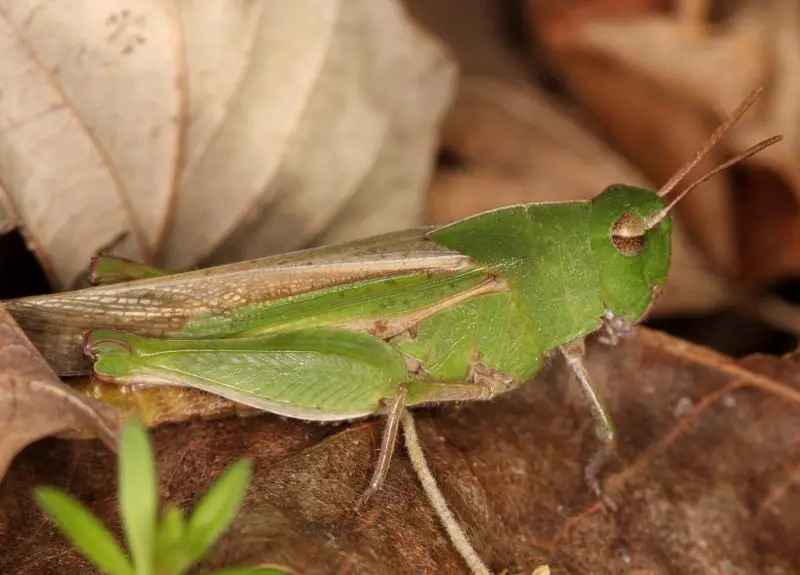
The Green-striped Grasshopper is medium to large, with adults measuring 30–40 mm. Its bright green body, combined with pinkish-brown markings on the legs and head, makes it easily recognizable. Two prominent green stripes run longitudinally along the thorax and abdomen.
Identification relies on the vivid green stripes, large hind legs, and long antennae. Females are larger and often bulkier than males, while males are more slender and agile. Wings are moderately long, allowing for short flights when necessary.
They inhabit moist meadows, marsh edges, and grassy areas with abundant vegetation. Green-striped Grasshoppers are often among the first species to appear in spring and remain active throughout summer. They favor areas with lush grass growth and moderate humidity.
Their diet consists primarily of grasses and soft herbaceous plants. They are active during the day and often seen hopping between blades of grass. While generally harmless to crops, they can feed on garden plants if populations are high.
Huckleberry Grasshopper (Melanoplus fasciatus)
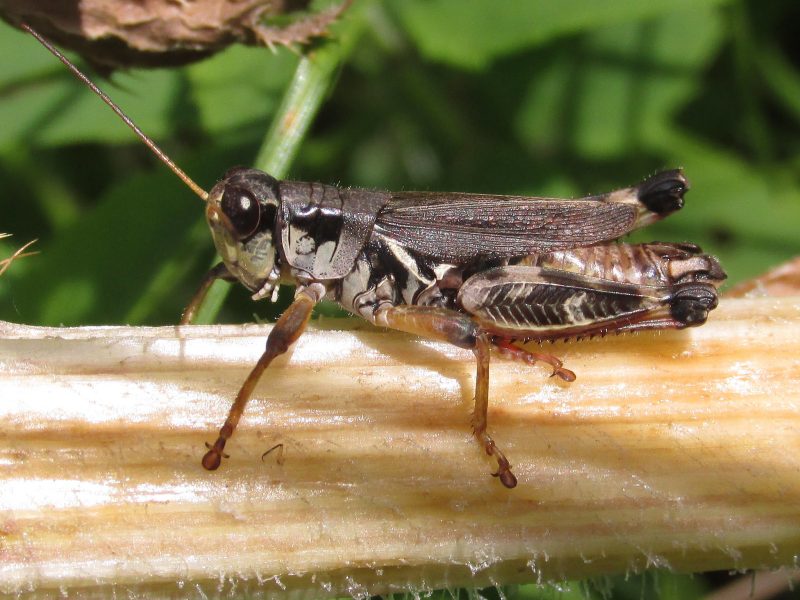
The Huckleberry Grasshopper is small to medium-sized, typically 20–30 mm in length. Its body is pale brown or tan with darker bands and subtle mottling, providing excellent camouflage among grasses and shrubs.
Identification is aided by faint lateral stripes along the thorax and the short, rounded wings in females. Males are slightly smaller with longer wings relative to body size, which aids in short flights. Hind legs are well-developed for jumping.
They prefer grasslands, prairies, and areas with shrubs such as huckleberry or low-growing plants. Huckleberry Grasshoppers are often found in clusters and are more abundant in areas with native vegetation. Seasonal activity peaks in mid-summer.
Feeding includes grasses, small shrubs, and herbaceous plants. They are relatively sedentary and rely on camouflage to avoid predators. Although they feed on some crop plants occasionally, they rarely reach outbreak levels.
Huron Spur-throat Grasshopper (Melanoplus huroni)
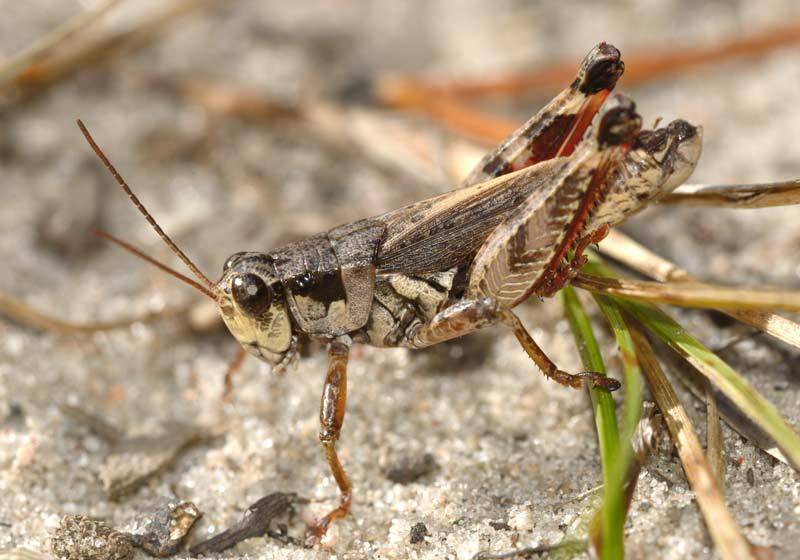
Huron Spur-throat Grasshoppers are medium-sized, ranging from 25–35 mm. Their body is usually tan or light brown with subtle darker markings on the thorax and wings. They have a small spur on the throat, characteristic of the Melanoplus genus.
Identification features include the throat spur, short wings in females, and long, strong hind legs. Antennae are moderately long and segmented, with males having slightly more slender bodies than females.
They inhabit open grasslands, prairies, and lightly wooded areas in Montana. They are more common in areas with native grasses and are often observed from late spring to early fall. They prefer warm, dry habitats with plenty of vegetation for feeding.
Huron Spur-throats feed primarily on grasses and herbaceous plants. They are capable of short flights but mostly move by hopping. They are not considered major agricultural pests but can contribute to grazing pressure in rangeland ecosystems.
Indigene Spur-throat Grasshopper (Melanoplus indigens)

The Indigene Spur-throat Grasshopper is medium-sized, generally measuring 25–35 mm. Its body is light brown to tan with subtle mottling, providing camouflage among grasses and sparse vegetation. A small spur on the throat distinguishes it from other local species.
Identification relies on the throat spur, short forewings in females, and strong hind legs for jumping. Males are slimmer and slightly smaller, while females appear more robust with broader abdomens. Antennae are moderately long and segmented.
They inhabit open prairies, meadows, and lightly wooded areas in Montana, favoring well-drained soils and native grasses. Seasonal activity peaks in mid to late summer when temperatures rise. Adults are mostly active during the day and can be observed hopping between plants.
Feeding consists mainly of grasses and herbaceous plants. They are relatively sedentary, usually staying in small groups. Although they occasionally feed on crops, they rarely reach levels that cause significant agricultural damage.
Keeler’s Spur-throat Grasshopper (Melanoplus keeleri)
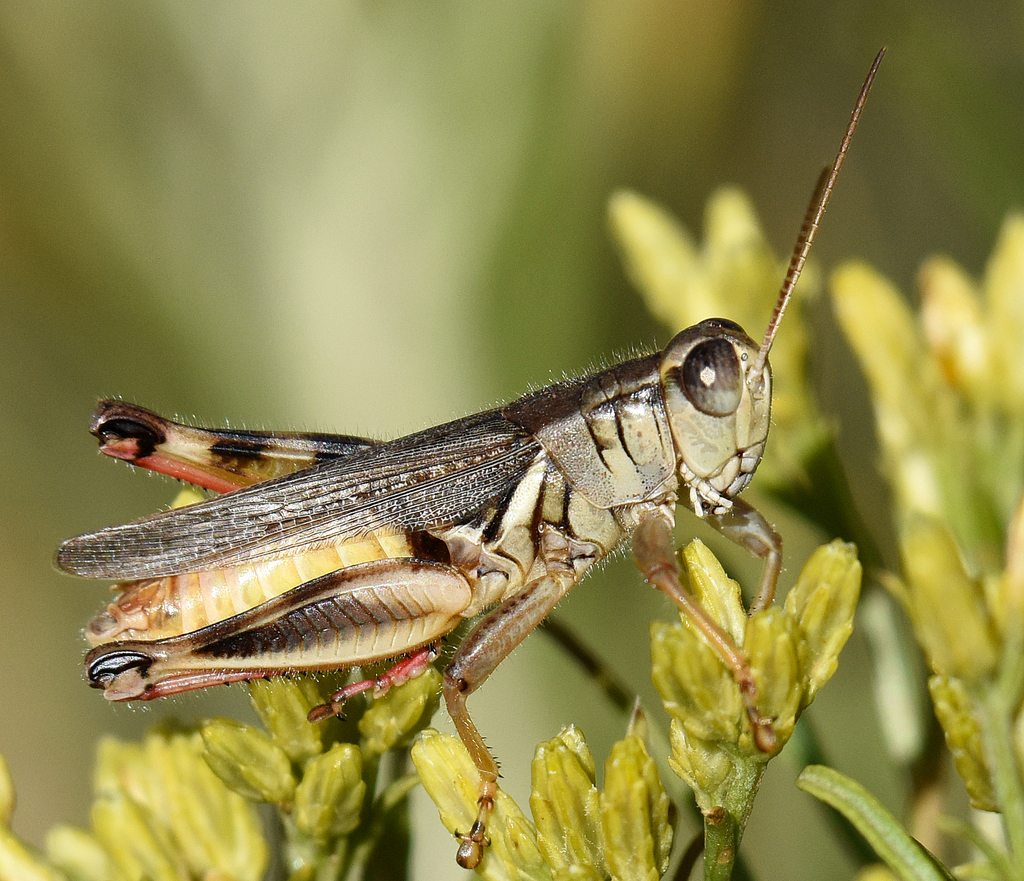
Keeler’s Spur-throat Grasshopper is medium-sized, ranging from 25–35 mm in length. Its body is tan to light brown with faint darker markings, blending well with prairie soils and dry grasslands. Like other Melanoplus species, it has a small spur on the throat.
Identification features include the throat spur, moderately short wings in females, and long, muscular hind legs. Males are smaller, more agile, and have slightly longer wings relative to their body size. The pronotum is slightly convex with fine longitudinal ridges.
They inhabit grasslands, prairies, and rangelands, preferring areas with native grasses. Adults are most active during the warm months of summer, often hopping among grasses to avoid predators. They are usually inconspicuous due to their cryptic coloration.
Keeler’s Spur-throats feed primarily on grasses and herbaceous plants. While they may occasionally nibble on cultivated crops, they are generally considered minor pests. Populations fluctuate with weather conditions and vegetation availability.
Mormon Cricket (Anabrus simplex)
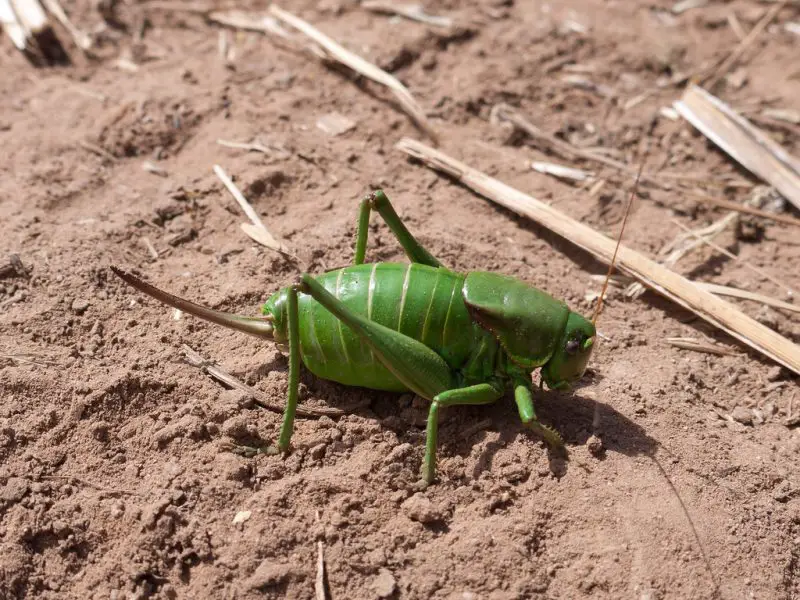
The Mormon Cricket is a large, flightless grasshopper, often reaching lengths of 60–80 mm. Its body is thick and robust, usually brown, gray, or greenish, with smooth wings that are mostly nonfunctional for flight. They are one of the more recognizable species in Montana due to their size.
Identification is straightforward due to the large size, wingless appearance, and heavy-bodied shape. Antennae are long and filamentous, while the hind legs are strong for long jumps. Nymphs are usually darker and smaller, gradually developing adult coloration over successive molts.
Mormon Crickets inhabit grasslands, rangelands, and open fields. They are highly mobile, often forming large migratory bands when local food resources are depleted. They are commonly seen during summer and fall months, especially after periods of warm, dry weather.
Their diet is omnivorous, feeding on grasses, forbs, and occasionally cultivated crops. During outbreaks, they can cause severe damage to pastures and crops, making them one of Montana’s most economically significant grasshoppers. They move in groups, which allows them to quickly deplete vegetation in an area.
Migratory Grasshopper (Melanoplus sanguinipes)
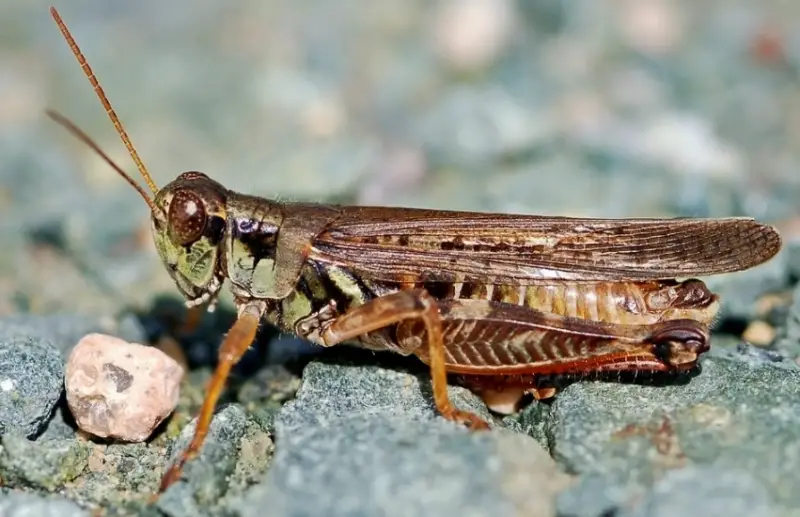
The Migratory Grasshopper is medium-sized, with adults measuring 25–35 mm in length. Their body is tan to light brown, often with darker markings along the thorax and wings. Hind wings are usually clear or lightly tinted, allowing for flight when disturbed.
Identification features include relatively long hind legs for jumping, short forewings in females, and a small throat spur characteristic of the genus Melanoplus. Males are slimmer and more agile, while females are bulkier.
They inhabit a wide range of habitats, including grasslands, prairies, croplands, and disturbed soils. They are highly adaptable and can be found throughout Montana. Activity peaks in summer, and they are known for their ability to move long distances in search of food.
Migratory Grasshoppers are generalist feeders, consuming grasses, forbs, and crop plants such as wheat and alfalfa. They are considered major agricultural pests due to their capacity to form large populations and rapidly consume vegetation, causing significant economic damage.
Montana Grasshopper (Asemoplus montanus)

The Montana Grasshopper is medium-sized, measuring approximately 25–35 mm. Its body is light brown with subtle greenish or gray tones, and its wings are relatively short, especially in females. The hind legs are strong, allowing for efficient jumping.
Identification is aided by its color pattern, short wings, and pronounced hind legs. Males are smaller and slimmer, while females are larger and more robust. Antennae are moderately long and segmented.
They are primarily found in grasslands, prairies, and montane meadows in Montana. They prefer well-drained soils and areas with abundant native grasses. Seasonal activity peaks in mid to late summer when temperatures are warm.
Feeding consists mainly of grasses and herbaceous plants. Montana Grasshoppers are not typically considered significant agricultural pests, but they may contribute to grazing pressure in rangeland ecosystems. They are generally solitary or found in small groups rather than large aggregations.
Northern Grasshopper (Melanoplus borealis)
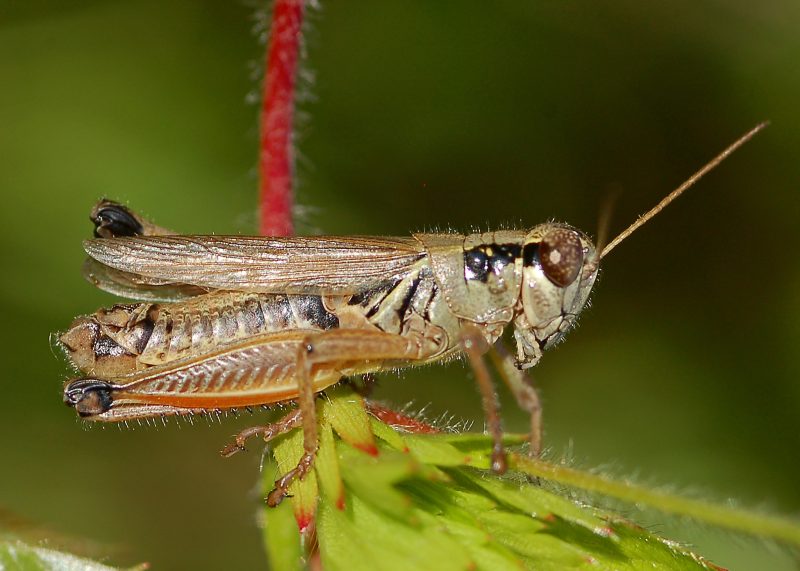
The Northern Grasshopper is medium-sized, usually 25–35 mm in length. Its body is tan to brown with subtle darker markings along the thorax and wings, providing camouflage in prairies and meadows. The hind legs are well-developed for jumping.
Identification is based on its robust body, short forewings in females, and a small throat spur characteristic of the Melanoplus genus. Males are slimmer and have slightly longer wings relative to body size. The antennae are moderately long and segmented.
Northern Grasshoppers inhabit open grasslands, prairies, and lightly wooded areas. They prefer areas with native grasses and moderate moisture. Adults are most active during warm summer months and are frequently observed hopping among plants.
They feed primarily on grasses and herbaceous plants. While generally not a major pest, they may occasionally feed on crops or garden plants. Populations fluctuate depending on weather conditions and food availability.
Packard’s Grasshopper (Melanoplus packardii)
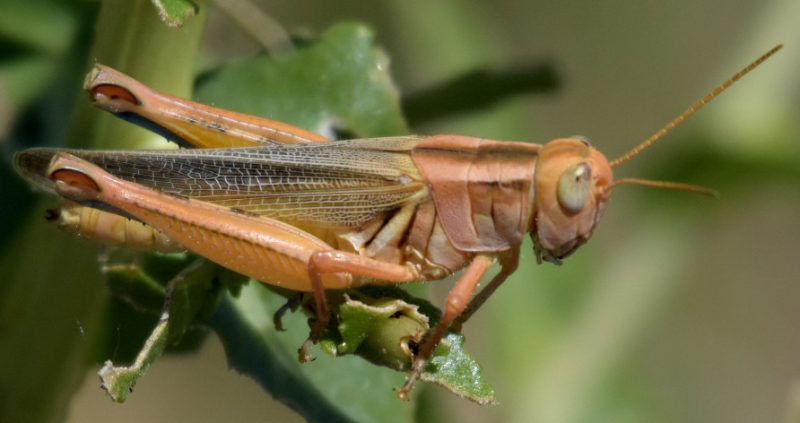
Packard’s Grasshopper is medium-sized, measuring about 25–35 mm. Its body is tan or light brown with faint darker patterns, helping it blend into prairie soils. Hind legs are strong and adapted for jumping.
Identification relies on the small throat spur, short forewings in females, and subtle lateral stripes along the thorax. Males are slimmer and more agile than females, with slightly longer wings relative to body size.
They are found in grasslands, meadows, and rangelands, preferring areas with native grasses. Adults are active during the warm months of summer and can be seen hopping among vegetation.
Packard’s Grasshoppers feed mainly on grasses and herbaceous plants. They are relatively sedentary, often staying in small groups, and are rarely considered significant agricultural pests.
Pallid-winged Grasshopper (Trimerotropis pallidipennis)
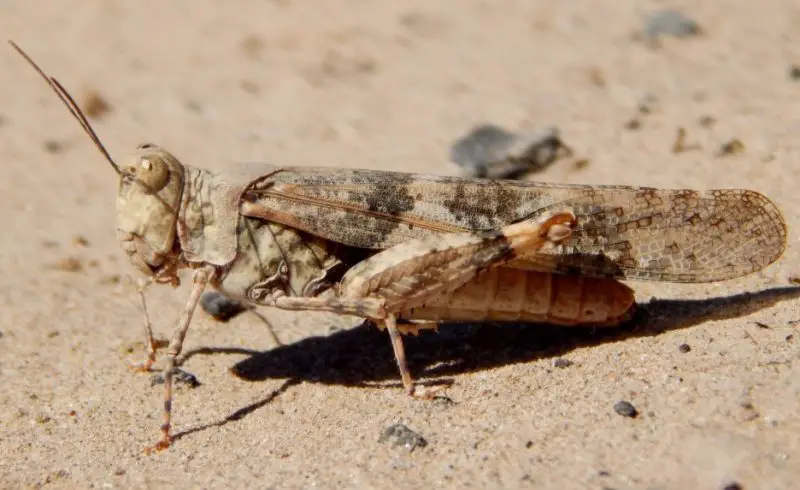
The Pallid-winged Grasshopper is medium-sized, typically 25–30 mm. Its body is light brown with subtle darker markings, and its hind wings are pale or translucent, giving it its name.
Identification features include the pale hind wings, slightly arched pronotum, and long, strong hind legs. Females have shorter wings than males, and both sexes display faint mottling that aids camouflage.
They inhabit dry, open grasslands, prairies, and sandy soils. They are most active during sunny, warm days and are often observed hopping between sparse vegetation.
Their diet consists primarily of grasses and low-growing herbaceous plants. They are highly mobile within their habitat but generally do not cause significant crop damage. Populations may increase in dry years with abundant vegetation.
Plains Lubber Grasshopper (Brachystola magna)

Plains Lubber Grasshoppers are large, flightless grasshoppers, reaching 50–80 mm in length. Their bodies are reddish-brown with black spots on the outer wings. They are slow-moving and easily recognized due to their size.
Identification is straightforward: large size, heavy-bodied, short wings that cannot support flight, and thick hind legs for hopping. Antennae are relatively short and stout.
They inhabit prairies, open grasslands, and areas with coarse vegetation. Plains Lubbers prefer dry, exposed habitats and are often seen resting on plants or the ground during the day.
Feeding is mainly on coarse grasses and broadleaved plants. They rarely affect crops and are considered minor pests. Their populations are usually stable and localized, without forming large outbreaks.
Short-winged Green Grasshopper (Melanoplus differentialis)
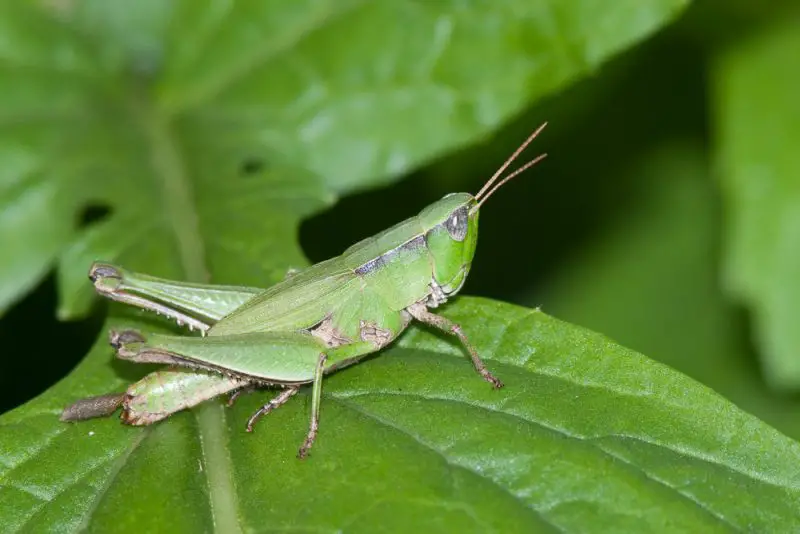
The Short-winged Green Grasshopper is medium-sized, around 25–35 mm. Its body is bright green, with short wings that barely extend past the abdomen in females. Males are slimmer with slightly longer wings.
Identification is aided by its vivid green coloration, short wings, and long hind legs adapted for jumping. The pronotum is slightly arched with subtle ridges, and antennae are moderately long.
They inhabit grasslands, prairies, and agricultural edges where grasses are abundant. They are active during warm summer days and prefer areas with lush vegetation.
Feeding mainly includes grasses and herbaceous plants. They are relatively sedentary and do not generally cause major damage to crops. Their green coloration provides excellent camouflage against vegetation, making them less noticeable to predators.
FAQs About Grasshoppers in Montana
What are the most common grasshopper species in Montana?
The most common species include the Two-striped Grasshopper (Melanoplus bivittatus), Green-striped Grasshopper (Chortophaga viridifasciata), Carolina Grasshopper (Dissosteira carolina), Northern Grasshopper (Melanoplus borealis), and Migratory Grasshopper (Melanoplus sanguinipes). These species are frequently found in grasslands, prairies, and rangelands.
Are any grasshoppers in Montana considered pests?
Yes, several species can cause economic damage. The Migratory Grasshopper (Melanoplus sanguinipes), Clear-winged Grasshopper (Camnula pellucida), and Mormon Cricket (Anabrus simplex) are known to feed on crops and rangeland plants, occasionally forming large populations that threaten agriculture.
How can I identify grasshoppers in Montana?
Identification usually involves observing size, color, wing length, patterns on the thorax and abdomen, and the presence of features such as throat spurs in the Melanoplus genus. Coloration varies from bright green to brown or gray, and wings may be short or long depending on the species.
When are grasshoppers most active in Montana?
Grasshoppers are most active during warm summer months. Many species emerge in late spring, peak in mid-summer, and remain active until early fall. Activity is influenced by temperature, rainfall, and vegetation availability.
Where are grasshoppers commonly found in Montana?
They inhabit a variety of habitats including open prairies, meadows, rangelands, alpine meadows, and disturbed sites like roadsides. Moisture levels and vegetation type influence the distribution of specific species.
Do Montana grasshoppers migrate?
Some species, such as the Migratory Grasshopper (Melanoplus sanguinipes) and Mormon Cricket (Anabrus simplex), can travel long distances in search of food. Most other species are relatively sedentary and remain within local habitats.
Are grasshoppers dangerous to humans?
Grasshoppers are not harmful to humans. They do not bite or sting and are primarily a concern for agriculture when populations become large. They play an important role in ecosystems by serving as food for birds, reptiles, and small mammals.





